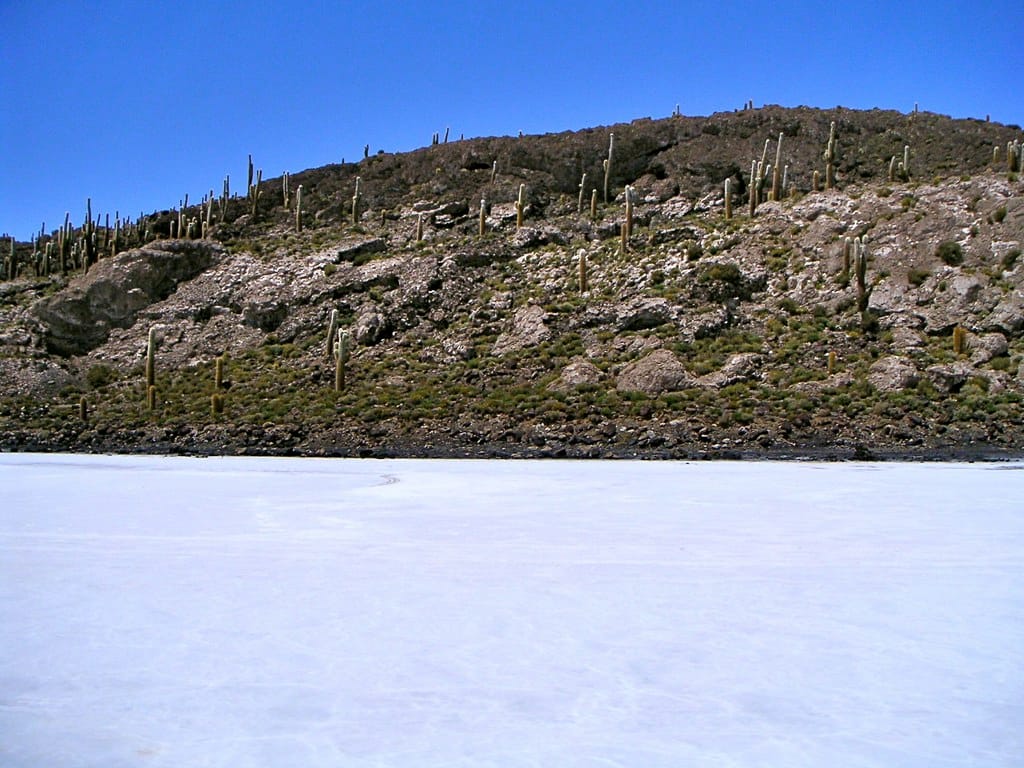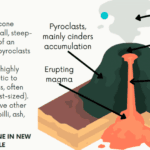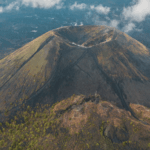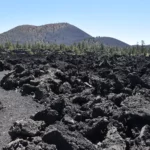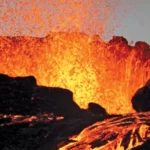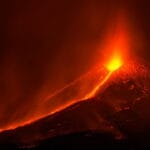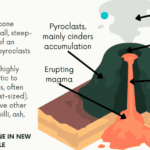As the sun rises over the vast expanse of the Salar de Tunupa, the world’s largest salt flat, its dazzling white surface transforms into a shimmering mirror that stretches as far as the eye can see. This extraordinary landscape, nestled in the heart of Bolivia’s Altiplano, is a testament to both the power of nature and the rich cultural heritage of the region. But there’s more to this ethereal landscape than just salt and sky. Towering above the shimmering expanse is Tunupa Volcano, a dormant giant steeped in Aymara legend and a key to understanding the true heart of this remarkable place. This is Salar de Tunupa: where ancient mythology meets breathtaking landscapes, offering a deeper exploration of Bolivia’s salt flats beyond the typical Uyuni experience.
Unveiling the Majesty of the Salt Flats
Imagine a place where the earth meets the sky, a vast expanse of white stretching to the horizon. This is the Salar de Tunupa, sometimes called Salar de Uyuni, a breathtaking natural wonder nestled high in the Bolivian Andes. Formed from prehistoric lakes that long ago evaporated, leaving behind a thick crust of salt, this place is a testament to the power of time and the beauty of geology. During the rainy season, a thin layer of water transforms the Salar into the world’s largest mirror, reflecting the sky and clouds in a mesmerizing display. It’s a photographer’s dream, a landscape artist’s muse, a nature lover’s paradise, and a truly unforgettable travel destination.
But there’s more to this region than just the salt flat. Dotted around the Salar are vibrant lagoons teeming with flamingos, their pink plumage a stark contrast against the white salt and blue sky. You can find bubbling hot springs where you can soak and relax, surrounded by breathtaking scenery. And there are strange, wind-carved rock formations scattered across the landscape, each a unique sculpture crafted by nature. Exploring these surrounding areas provides a deeper understanding of the Altiplano’s rich biodiversity and geological history. For a beautiful and vast view of the marvels of nature and relaxing in the tranquility of a surreal place, you can visit Skyline Gate Staging Area in Salar de Uyuni.
The Legend of Tunupa Volcano
Rising majestically from the shimmering white plane is Tunupa Volcano, a dormant giant that adds to the otherworldly atmosphere. Tunupa isn’t just a geological feature; it’s a cornerstone of local Aymara culture. Considered sacred by the indigenous people, the volcano and the salt flat are woven into their myths and legends. Some stories say Tunupa, a powerful deity, wept salty tears that created the Salar. Others whisper of mountains that wandered the earth and nursed their young, their milk transforming into the salt. Visiting this place, you can almost feel the presence of these ancient tales, adding a layer of mystique to the already incredible scenery.
Tunupa Volcano itself is a dormant stratovolcano formed by lava flows during the Pleistocene era, standing at 5,321m (17,457 ft) and showing signs of past glacial activity. Situated north of the Salar, it dominates the landscape and offers challenging climbs for adventurous travelers.
Planning Your Salar de Tunupa Adventure
Getting to the Salar de Tunupa requires a bit of planning, but it’s absolutely worth the effort. You can join organized tours, which are probably the easiest way to experience the area. These tours typically range from day trips to multi-day expeditions, offering varying levels of exploration. This isn’t your average beach vacation. It requires preparation and awareness of the unique challenges and opportunities this high-altitude environment presents.
Tour Options
| Tour Type | Duration | Typical Activities |
|---|---|---|
| Day Trip | 1 day | Visiting the salt flat, taking perspective photos, maybe a quick stop at a nearby village |
| Multi-Day Expedition | 2-4 days | Exploring the salt flat, visiting lagoons and hot springs, climbing Tunupa Volcano, stargazing |
| Customized Tour | Variable | Tailored itinerary to your specific interests |
Accommodation options cater to different budgets and preferences, from basic hostels to more comfortable hotels in nearby towns like Uyuni. It’s important to book in advance, especially during peak season.
Altitude and Safety
One important thing to consider is the altitude. The Salar de Tunupa sits at a dizzying 3,656 meters (11,995 feet) above sea level. Altitude sickness can be a real issue, so it’s wise to spend a couple of days acclimatizing in a higher altitude city like La Paz before heading to the salt flats. Drink plenty of water, take it easy on your first day, and listen to your body.
Additional safety considerations include navigation (the vastness of the Salar can be disorienting), weather (conditions can change rapidly), and wildlife encounters (maintain a safe distance). Choosing reputable tour operators who prioritize safety and have experience navigating the Salar is highly recommended.
Responsible Travel
Finally, and perhaps most importantly, let’s talk about responsible travel. The Salar de Tunupa is a fragile environment, and it’s crucial that we treat it with respect. Choose tour operators that prioritize sustainable practices, avoid littering, and be mindful of the local communities and their traditions. By traveling responsibly, we can ensure that the Salar de Tunupa’s beauty and magic are preserved for future generations to enjoy.
Salar de Tunupa: A Scientific Marvel
Beyond its stunning beauty and cultural significance, Salar de Tunupa holds immense scientific value, particularly for space agencies like NASA. Its extreme flatness and highly reflective surface make it an ideal location for calibrating Earth-observing satellites. This “natural mirror” helps ensure the accuracy of satellite data used in a variety of scientific endeavors.
Satellite Calibration
NASA uses Salar de Tunupa to calibrate two key types of satellite instruments: imagers and altimeters. Imagers capture the colors and light intensity of the Earth’s surface, while altimeters measure height and distance. By comparing satellite data from the Salar with known values, scientists can fine-tune these instruments, ensuring accurate measurements for monitoring vegetation health, tracking deforestation, measuring sea levels, and even predicting natural disasters.
| Instrument Type | What it measures | How Salar de Tunupa helps calibrate it |
|---|---|---|
| Imager | Colors and light intensity in satellite pictures | Provides a known, consistent surface to check color and brightness accuracy |
| Altimeter | Height and distance | Provides a large, flat surface with a known elevation for accurate height measurements |
It’s important to acknowledge that our understanding of Salar de Tunupa, like many natural wonders, is continuously evolving. Ongoing research may reveal new insights into its formation, ecosystem, mineral resources, and potential for future satellite calibration techniques.
Unveiling the Secrets of the Salar
The Salar de Tunupa is more than just a destination; it’s an experience. It’s a journey into a land of myths and majesty, a geological marvel and a cultural treasure, a place where the earth whispers ancient stories and the sky reflects infinite possibilities. So, if you’re looking for an adventure off the beaten path, a journey to a place that feels like another world, the Salar de Tunupa awaits. Just remember to pack your camera, your sunglasses, and a sense of wonder.
Remember, ongoing research and exploration continue to reveal the secrets of this extraordinary place. So, while this article provides a comprehensive overview, there’s always more to discover about the Salar de Tunupa, making it a truly captivating destination for years to come.
- Unveiling Bernhard Caesar Einstein’s Scientific Achievements: A Legacy in Engineering - July 15, 2025
- Uncover who is Jerry McSorley: CEO, Family Man, Business Success Story - July 15, 2025
- Discover Bernhard Caesar Einstein’s Scientific Contributions: Unveiling a Legacy Beyond Einstein - July 15, 2025
